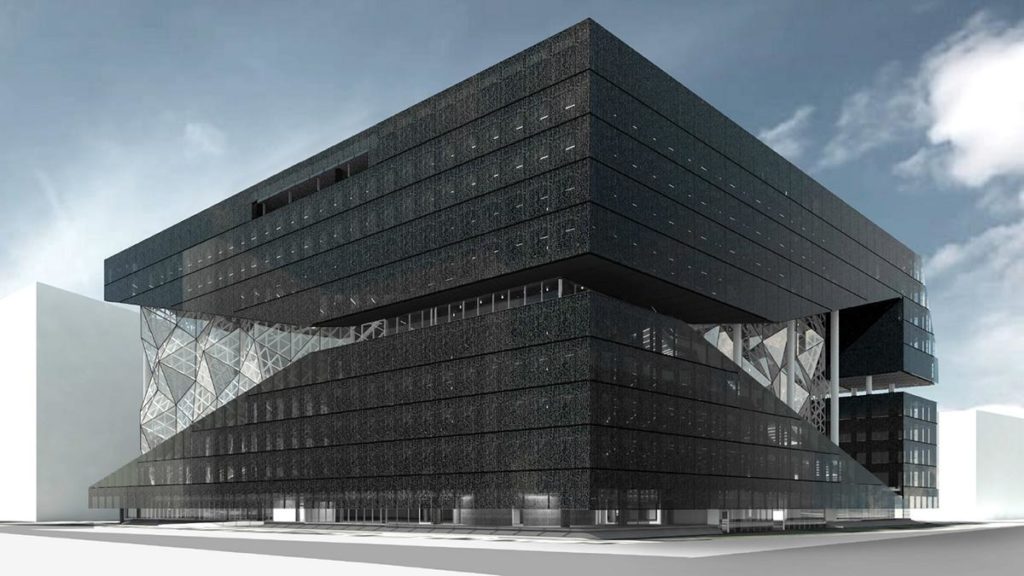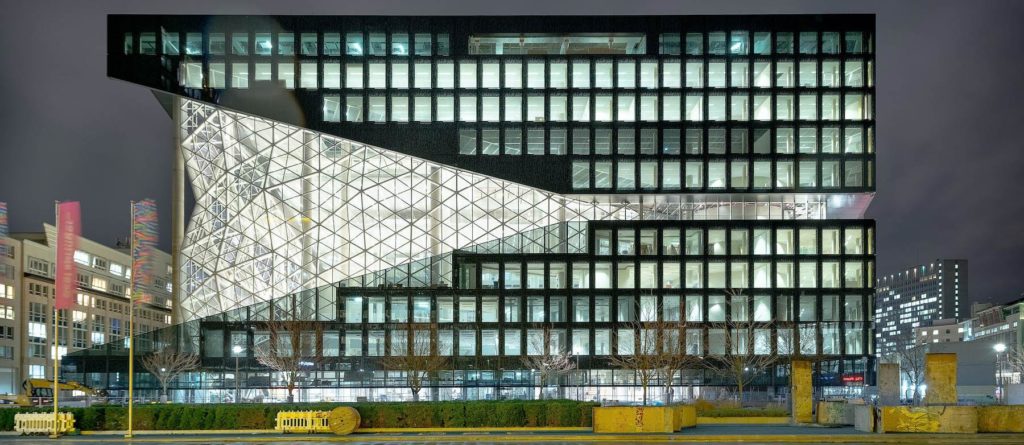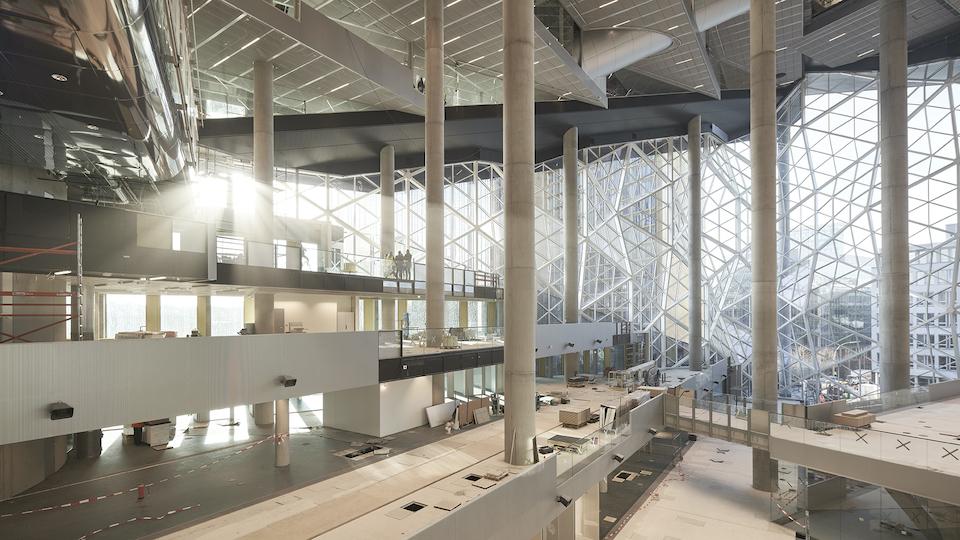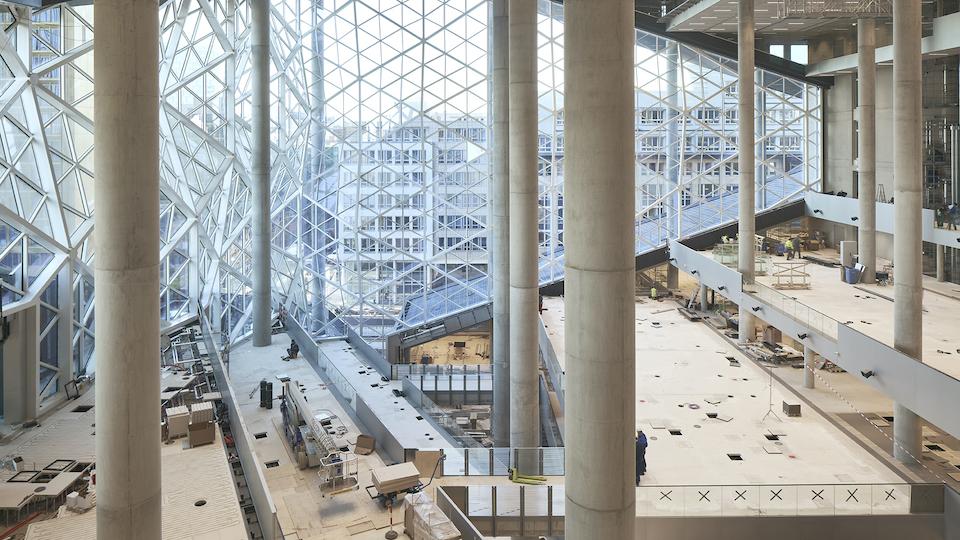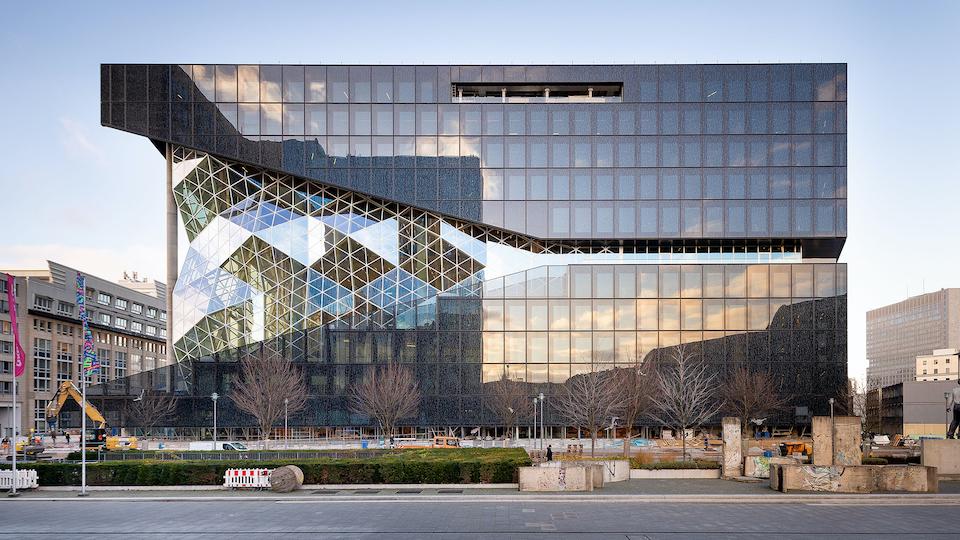Axel Springer: new headquarters as a statement
Berlin has a new landmark: the new Axel Springer building. The avant-garde complex isn’t just an urban statement, it also stands for the future of working in the digital world.
Even renowned architects like to be playful. In his breathtaking design for the Axel Springer building in Berlin, renowned Dutch architect Rem Koolhaas used the old border between east and west as one of the central design themes and aligned the underlying concept with it.
Integration of East and West Berlin
The futuristic building on Axel-Springer-Strasse, not far from Checkpoint Charlie, is divided into a north and a south section. The dividing line of both wings runs diagonally through the enormous cube and virtually along the former border. Both halves of the building are joined by a transparent bridge that extends diagonally through the vast atrium.
In a nutshell: the newly opened Axel Springer building is not only a bold architectural statement by one of Europe’s largest media organizations. It makes a statement in many respects.
The many statements of the Axel Springer building
Its placement at the heart of the old, historically important newspaper district – this is a statement. Its location in the immediate vicinity of the existing Axel Springer high-rise building – also a statement. And this building that was erected between 1959 and 1965 during the era of the legendary German press baron Axel Caesar Springer (1912-1985), was and is an unambiguous statement. It was built directly at the border to East Berlin and thus stood right next to the deplorable Berlin Wall that separated Berlin into east and west from 1961.
The start date of the project for the new building is a further statement. The official start of construction was October 6th, 2016 – which was exactly 50 years after the opening of the golden high-rise that still exists and is in use today. And the new building itself is naturally a statement. It stands for the future direction of the Group as a whole and for the future way of working in the world of digital media.
Axel Springer SE is a publicly traded publishing group that owns a range of multimedia brands, such as “Bild” and “Die Welt”. In the financial year 2018, its 16,350 employees generated a consolidated turnover of 3.2 billion euros for the Group. Digital activities make up around 71% of sales.
“We haven’t just developed a spectacular building here, it is a meeting place where people will be able to interact and collaborate more effectively,” announced Mathias Döpfner, CEO of Axel Springer SE, a few days before the keys were handed over on December 19th, 2019. Axel Springer has transformed itself into a thoroughly digital company. The new building is a pledge to all employees that Axel Springer’s cultural transformation will be further accelerated. Döpfner continued: “We want our new building to bring together the Axel Springer family in Berlin spatially while simultaneously shaping the future of working in the digital world through architecture. It is about a home that is strong in symbolism, but above all about using radically modern workspaces to bring about cultural transformation.”
A competition between 18 architecture firms
The new office building lies in the immediate vicinity of the Axel-Springer-Passage in the Kreuzberg district and was designed by Dutch architect Rem Koolhaas and his Office for Metropolitan Architecture (OMA). Koolhaas and his firm were selected as winners of the design competition ahead of 18 other architect’s offices.
The task facing the architects was to develop concepts that create additional space for the growing divisions of Axel Springer. Besides this, the planned structure was supposed to set new standards in terms of atmosphere, potential use and interior design for a modern working environment.
Renting a cube
Koolhaas designed a building that is flooded with light and in the shape of a cube. Its central element is a 45-m high atrium with a volume of approximately 120,000 m³ over nine floors. The atrium would hold the water from 40 Olympic swimming pools. Costing 300 million euros, the complex also boasts terraces, glass walls, columns and bridges in the interior, and façade elements with a 3D visual effect. Talking of money, long before it was finished, the Axel Springer Group sold the new building to a Norwegian SWF. In future, Springer will only be the tenant.
The transparent, open architecture succeeds in uniting radical aesthetics with modern working concepts.
Official statement of the Axel Springer Group
Radical aesthetics, working environment of the future
The exterior of the spectacular building is characterized by the two flanks, each of which opens up like a wedge towards the front façade giving rise to an enormous, transparent surface. The front façade itself largely maintains this transparent look that is reminiscent of a space station. Axel Springer: “The transparent, open architecture succeeds in combining radical aesthetics with modern working concepts. Together with the existing Axel Springer publishing buildings, a complex has been created that is expected to meet the requirements of a digital media and technology company as specified by the company.”
Room for 14 football pitches
The extraordinary building has 13 floors, eleven above ground and two below. Completely new vistas of the terrace-like levels are offered, depending on the floor you are on. The complex stands on a 10,000 m² plot, the large “Lindenpark site”. With over 52,000 m² of floor area, the finished building will accommodate offices, editorial departments and space for 3,500 employees. A total glass surface of 99,500 m² was installed inside and out, which is equivalent to 14 football pitches.
This remarkable new building will accommodate the daily and Sunday paper “Die Welt” with its newsroom for print and digital products, as well as the “Welt” TV studio. All the editorial departments connected with the “Bild” brand will remain at the current premises.
News from on high
The transparent two-storey bridge mentioned earlier spans the atrium dozens of metres above the ground. In future, the “Welt” newsroom will be on this bridge on the 5th floor. The “Welt TV” newsroom will be located on the bridge one floor further up. The two editorial departments will be connected via an individual staircase, enabling them to quickly collaborate with each other when necessary.
Our staff are even free to grow their own tomatoes on the roof.
Mathias Döpfner, CEO of Axel Springer SE
The roof of the media centre is to be accessible to the public. The plan is to set up allotment gardens there for the employees. “They will be able to grow their own tomatoes there,” said Döpfner. A bar is also planned for the roof area. The Springer staff were closely involved in all stages of the project from the design phase onward. While they understandably couldn’t have a direct hand in the design of the building, the ideas, wishes and suggestions they voiced during numerous workshops and meetings were mostly taken into consideration during the planning phases.
Special website for the new building
In order to communicate information on the complex and to document construction progress, Axel Springer set up a website specifically for the new building (www.axelspringer-neubau.de). In addition to hosting numerous articles, various films and regular podcasts have been published here too, featuring persons such as Axel Springer CEO Mathias Döpfner.
The official opening and inauguration of the new office building will be celebrated by Axel Springer at the beginning of 2020 with a series of events focused on the history and future of the company. These will range from a small commemoration ceremony to events for the general public.
Text: Albert Sachs
Translation: Rosemary Bridger-Lippe
Photos: Axel Springer SE/OMS, Nils Koenning, Dominik Tryba
